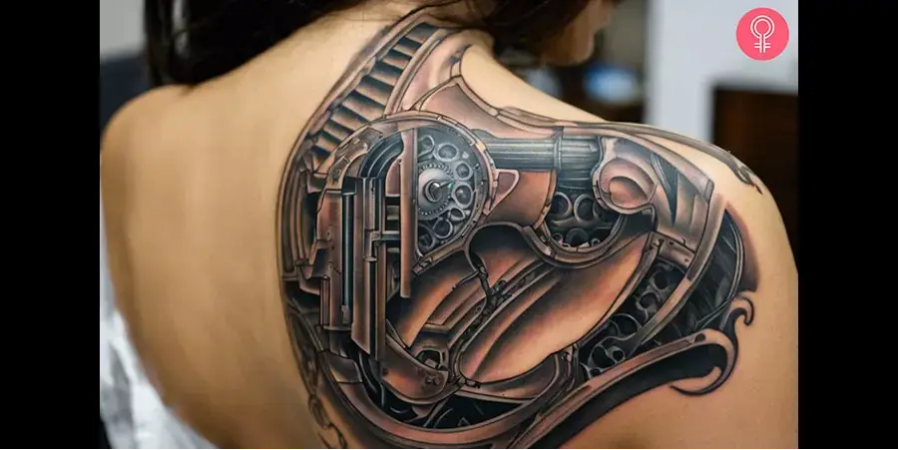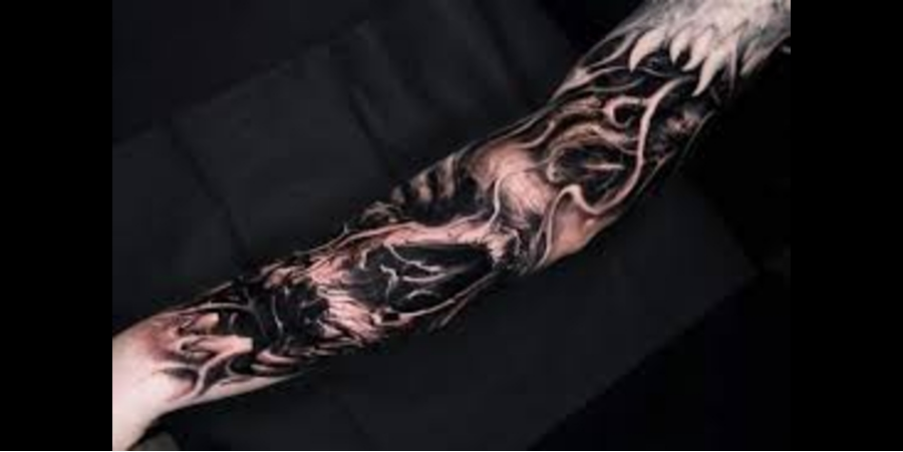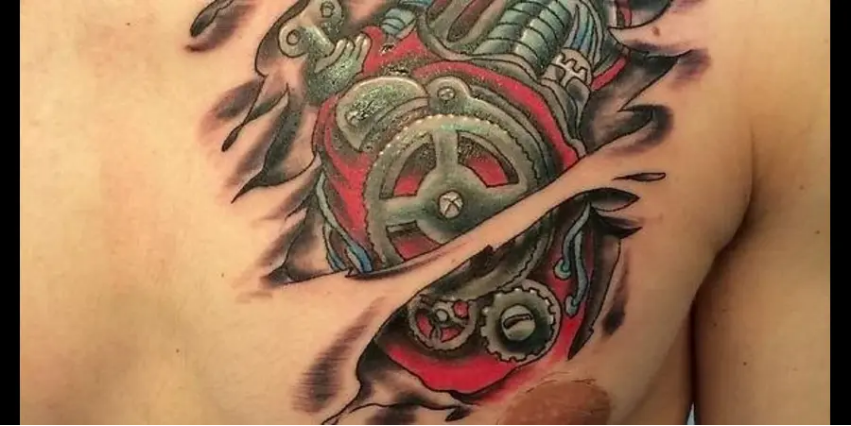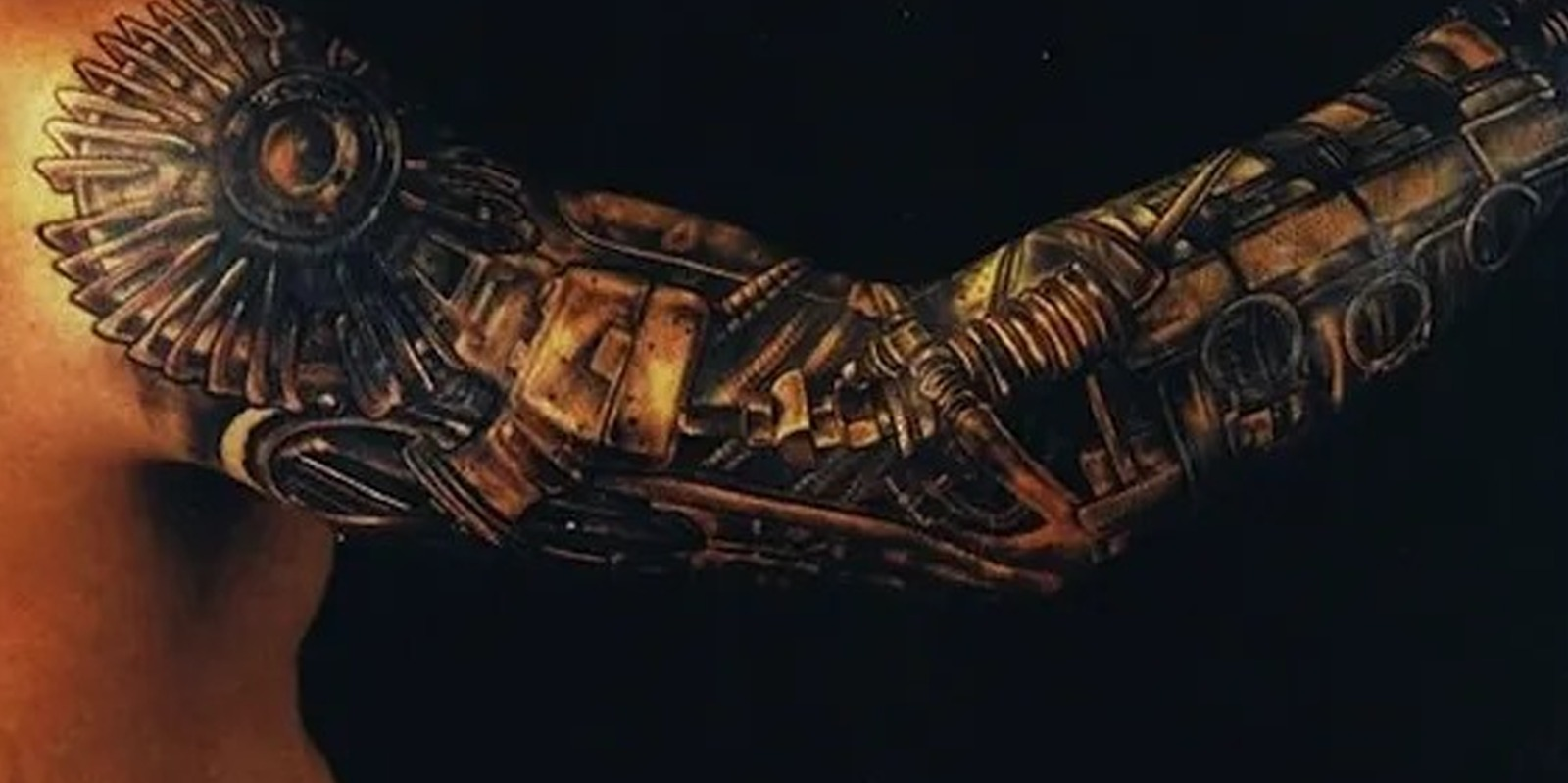Introduction
Biomechanical tattoo is a unique fusion of ink, skin, and science fiction, blending elements of anatomy with mechanical designs to create an illusion of complex systems beneath the surface. These tattoos often feature gears, pistons, and cybernetic enhancements, influenced by late 20th-century aesthetics. The style, heavily influenced by Swiss artist H.R. Giger, has captivated artists and enthusiasts alike. It serves as a representation of human potential and the blend of man and machine, offering a tribute to futuristic aesthetics through unique, awe-inspiring body art
What Are Biomechanical Tattoos?
Biomechanical Tattoo At their core, biomechanical tattoos integrate organic human anatomy with mechanical parts such as gears, circuits, and metallic components. These designs follow the body’s natural contours, creating the illusion of an internal cybernetic structure beneath the skin. Using advanced style, shading, and 3D effects, these tattoos achieve intricate detailing for a hyper-realistic effect.
Biomechanical Tattoo Some variations, like bioorganic tattoos, share a relative philosophy, replacing elements like bones with vines or alien-like structures. The result is a futuristic, surreal aesthetic where machine and flesh merge seamlessly, giving an almost natural, earthy appearance.
The Origins and Evolution
The origins of biomechanical tattoos can be traced back to H.R. Giger, a visionary artist known for his disturbing yet mesmerizing creature designs in the Alien film franchise (1979). His dark, surreal depictions of biomechanical beings inspired tattoo artists to explore similar designs on human skin.
Other notable influences include fantasy artists like Boris Vallejo and Frank Frazetta, who contributed to sci-fi and fantasy art movements, helping to shape the genre as we know it today. As a niche art form, biomechanical tattoos have evolved alongside technology and tattoo techniques, gaining widespread popularity. Modern tattoo artists have pushed the boundaries of realism, incorporating glowing elements, advanced shading techniques, and hyper-detailed designs for a lifelike appearance.
Types of Biomechanical Tattoos
Realistic Biomechanical Tattoos

These designs create the illusion of a genuine cybernetic structure beneath the skin. With realistic shading, depth, and detailing, these tattoos result in jaw-dropping pieces that elevate the genre.
Organic Biomechanical Tattoos

A mix of mechanical components and anatomical features, these tattoos incorporate bones, tendons, and muscle fibers to create a hybrid between the natural and the mechanical.
Biomechanical Skull Tattoos
The skull is a powerful symbol in biomechanical tattoos, representing mortality and strength while merging life with machinery.
Biomechanical Heart Tattoos

A fusion of the human heart and machine, these designs often include pistons, gears, wiring, arteries, and veins, symbolizing resilience and technological advancement
A fusion of the human heart and machine, these designs often include pistons, gears, wiring, arteries, and veins, symbolizing resilience and technological advancement
Best Placements for Biomechanical Tattoos
Biomechanical Sleeve Tattoos
A full or half sleeve is an excellent way to showcase the intricate details of biomechanical art, allowing for complex storytelling through design.
Biomechanical Shoulder Tattoos
The shoulder’s natural curves provide a strong foundation for gears and joints, making it a popular choice for biomechanical pieces.
Biomechanical Chest Tattoos
The chest is an ideal spot for large, dramatic designs, creating the illusion of exposed ribs interwoven with mechanical components. Biomechanical tattoos in this area highlight detailed muscles, skin, and mechanical elements, combining bio-organic and futuristic structures to achieve visual complexity. The organic flow of hardware with the body’s natural form results in a striking piece of tattoo art.
Finding the Right Artist
Due to the complexity of biomechanical tattoos, choosing a skilled artist is crucial. A great tattooist should have a strong portfolio showcasing hyper-realistic work and a deep understanding of human anatomy. Experience in 3D shading, perspective techniques, and the ability to customize designs to fit the body’s natural flow is essential.
The Pain Factor & Cost
Biomechanical tattoos require multiple layers of shading and fine details, making them more time-consuming than standard designs. A premium, high-quality piece—especially if large and intricate—can take several sessions to complete.
Pain levels vary based on placement; areas with less fat, like the ribs, hands, and spine, tend to be the most painful. However, many enthusiasts find that the end result outweighs the discomfort.
Aftercare and Maintenance
Biomechanical Tattoo To ensure proper healing, it’s important to keep it clean by washing with fragrance-free soap and water. Regular moisturizing with tattoo-specific lotion prevents dryness and irritation.
Avoid sun exposure, as UV rays can fade the ink. Once the tattoo is healed, always apply sunscreen to maintain its vibrancy. Following the artist’s instructions is essential for long-term tattoo preservation.
Conclusion
Biomechanical tattoos are a fusion of art and technology, transforming the body into a canvas for futuristic storytelling. The realistic intricacy of organic-mechanical blends, often inspired by dark, sci-fi themes, continues to push the boundaries of tattoo design. Finding the right artist and following proper aftercare ensures that your tattoo remains stunning for years. Whether it’s a personal journey or a tribute to cybernetic advancement, a biomechanical tattoo is a masterpiece in the making.


Pingback: What Does the Bible Say About Tattoos? - choosewise.info